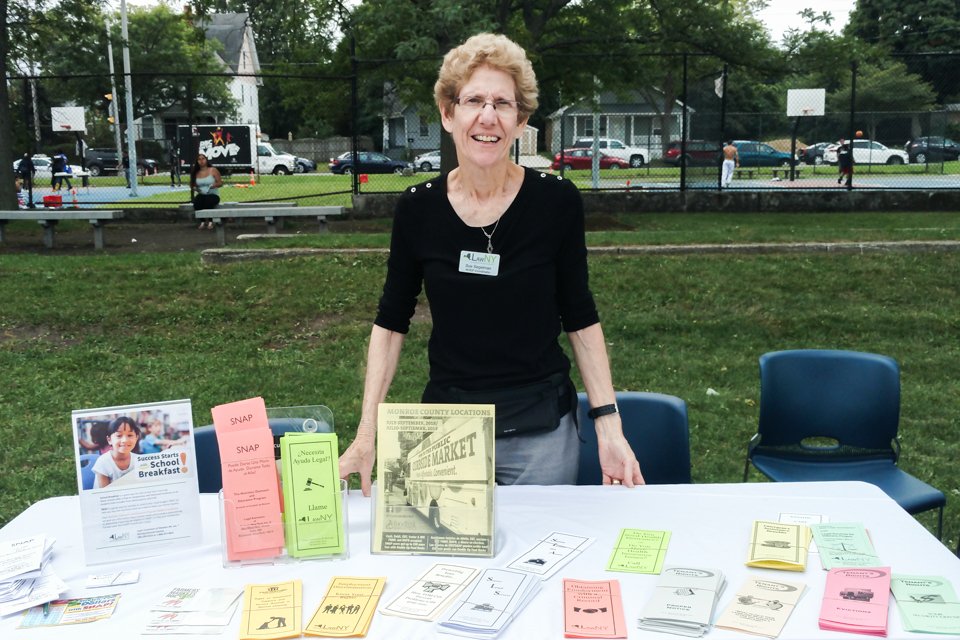By Matt Kelly
Lack of access to fruits and vegetables is directly related to higher rates of illnesses in many of our communities. But what if we removed the problem of access as a contributor to these health inequities in our region? Can we use our region’s agricultural abundance to ensure access to healthy food for all residents?
This article is part of an on-going series that explores these questions.

Sue Segelman at a community event sharing information about local food resources. Photo courtesy of Sue Segelman.
Earlier this year we sat down with Sue Segelman, the nutrition outreach and education program coordinator at Legal Assistance of Western New York, Inc., to talk about what she sees as our region's greatest challenges to ensuring access to fruits and vegetables for everyone. We also talked about the "programs of promise" that help make fruits and vegetables more widely available.
"If I had to choose one greatest challenge, based on the clients we deal with, I’d have to say it’s not having enough money," says Segelman.
Whether that means funding from the supplemental nutrition assistance programs WIC, for women, infants and children, and SNAP, also known as food stamps, or actual dollars, the problem is financial resources are lacking for individuals and families. Segelman says she hears time and again, “I just don’t have enough to buy what I want.”
"Although most of my focus is SNAP, I’m always running down the list of every other resource we’re aware of that seems to fit their situation," she says. "But affordability is always the focus, and always part of the conversation."
Unfortunately, people often see the bureaucracy of dealing with service agencies to be daunting. "It's a balancing act between the benefits you’d receive versus the trouble and time required," says Segelman. "Clients may perceive that it’s just not worth all the trouble to fill out forms, make copies, have a phone interview and so on for $15, $30 or even $60 a month in SNAP benefits. The process required is very demanding."

The Summer Meals Partnership of Rochester. Photo source: www.summermealsroc.org
Transportation can also be a challenge for people trying to take advantage of available resources. For example, the Summer Meals Partnership of Rochester runs a summer meals program for children 18 years and younger at various sites throughout the city of Rochester. "And maybe the nearest one is only three blocks away on a map," says Segelman. "But those three blocks may require children to cross over Plymouth Avenue or Genesee Street or a highway on the way."
It’s the same issue with accessing grocery stores. On a map, it might be only half a mile to the nearest food retailer. Without a car, that half-mile likely means the person is taking a bus or a very long walk. "You can only carry two to three bags at a time," says Segelman. "And it would take five or six bags in order to buy things in quantity and save money. But you can’t carry five or six bags if you’re walking or riding the bus."
Someone without a car simply does not have equal access to healthy, affordable food. At large retailers, people can buy food in quantity and get a better value. But you can only benefit from buying in quantity if you have a way to get all the items home.
So what are the programs of promise for people who face these challenges and who also want to regularly have fruits and vegetables on their plates?
"I would definitely say Foodlink’s Curbside Market is first and foremost a program of promise," says Segelman. "The food is very affordable, and SNAP is not just accepted but rewarded."
Curbside Market offers the Double Up Food Bucks program, which doubles the value of federal assistance dollars up to $10 each and every time a person shops at the mobile market.

Photo courtesy of Communication Bureau, City of Rochester
"The Rochester Public market also gives a 40 percent discount for using SNAP," she says. The discount is part of a wider effort by a coalition of farmers markets that includes those in Brighton, the South Wedge and on the west side on Genesee Street. "They’re also providing education about how to shop affordably and how to cook and use the food that’s sold there."
Segelman has also been watching a USDA program that would provide grants to assess the feasibility of making food delivery available to low-income people from local grocery stores. According to Segelman, Hart's Local Grocers is the only store in the Rochester area to be awarded the grant. However, the money will only pay for Hart’s to study the logistics and marketing needed to make home delivery to low-income individuals a viable reality; it would not pay for the actual delivery costs.
Segelman says she is continually amazed by how many people don't know about the range of programs available to them – including major resources such as the Public Market, Curbside or even SNAP. "No matter how well you think you’ve marketed a program, some people still won’t know about it," she says.
This is why she always recommends 2-1-1, a phone number that people can call 24 hours a day to get information about basic resources like food and shelter. "Someone just needs to call up and say, 'This is where I live. Where is the closest farmers market or Curbside stop or food pantry or soup kitchen?'”
People can also go to the 2-1-1 website to find the same information.
--
We’d like to thank Sue Segelman for all the work she does to connect members of our community with the resources they need and for her help with this story.
Related Links:

